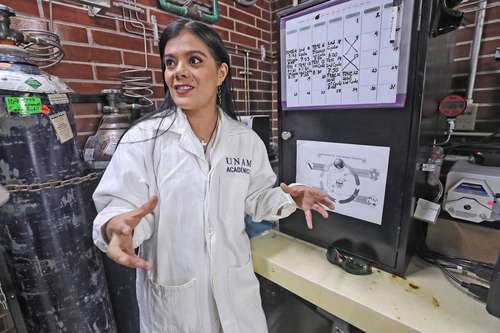Developed at UNAM green method
for sustainable hydrogen production
Colored tubes that go from one wall to another, valves that indicate pressure or temperature, computers that display graphs, shelves with bottles, test tubes, hoses, as well as signs that indicate photocatalysis
, hydrogen production
. This is Laboratory 6, of the Materials Research Institute (IIM), of the National Autonomous University of Mexico, where Karen Valencia García and a group of colleagues, under the advice of Sandra Elizabeth Rodil Posada, carry out studies on the generation friendly
of hydrogen.
Valencia García, doctor in materials science and engineering, receives The Conference in his workspace to talk about the central topic of his research: “preparation of the CdS/g-C3N4 heterojunction on site and evaluation of its photocalytic properties in the visible”, which was recognized by the highest university as the best doctoral thesis of 2023 in the area of materials science and engineering.
The work focused on finding a green method
for the production of hydrogen and convert it into an alternative to fossil fuels, which contribute to climate change and affect the health of the population.
“In the face of global warming and the health problems caused by greenhouse gases, such as the carbon dioxide generated by fossil fuels – natural gas, hydrocarbons, coal –, hydrogen has been presented as the fuel of the future because At the time of combustion it only produces water vapor,” he explained.
From a chair, located on the side of a black box – very similar to a safe – and inside which hydrogen is produced from her research, the specialist pointed out that if this element has not been able to become an alternative to fossil energy is because it is not found naturally on Earth in a gaseous state, but is anchored in other materials.
Although in many countries it is already used as a source of energy to power cars or trains, hydrocarbons are used for its production. So, although hydrogen produces water vapor during its combustion, if hydrocarbons were used to produce it, we fall into the same situation: we leave a footprint of carbon dioxide. Faced with this problem, our approach was to look for a way to produce hydrogen free of the use of hydrocarbons.
.
For four years, Valencia García and his colleagues worked on the design of materials that could be activated with solar energy, absorb it and pass it on to hydrogen-rich molecules – in this case water, which has two hydrogen molecules and one of oxygen (H2O) – and separate them.
The two materials that Valencia García worked with were carbon nitride and cadmium sulfide, to which he made modifications until one of them absorbed a broad spectrum of solar energy
and the other took it to the nanometric scale so that both could separate the water molecules into hydrogen and oxygen.
Valencia García is a young woman, with long hair and arched eyebrows, who feels happy about her research. She says that, although the process was not easy and there were several tests that did not have the expected result, When we saw that these two elements were synergizing and we were producing hydrogen, it was something incredible! We almost jumped in the laboratory
.
This research is relevant, he added, because it brings humanity closer to the production of hydrogen in a sustainable way and to the amount that is required to be economically and ecologically viable as demanded by the population.
Getting more hydrogen produced brings us one step closer to independence from hydrocarbons
accurate.
The researcher is very disciplined, she starts her day at 5 in the morning, she exercises for more than an hour and after having breakfast she goes to her laboratory, where she works until 6 p.m. Then, she returns to her house, does some meditation, and reads for a couple of hours on topics of interest to her, at 10 p.m. she goes to rest.
A characteristic feature of his personality is curiosity, perhaps that is why now that this first investigation is completed, the work team, under the coordination of Agileo Hernández Gordillo, doctor in chemical sciences, is focused on studying the possibility of using dirty water or contaminants. to generate hydrogen and at the same time degrade waste.
I came to this topic and I continue working on it, because I am a nature lover, and I am concerned about the transformations generated by climate change. This was my main driving force in these four years: I know that I can contribute a little to solving this problem
he concluded.
